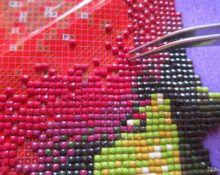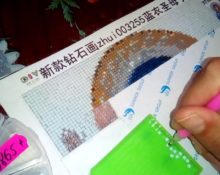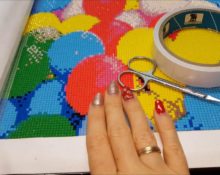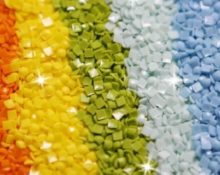Shimmering rhinestones and modest clothes will make them luxurious! You can decorate your favorite item with a shining scattering yourself. The most convenient thing is thermal rhinestones. Read on to learn how to brilliantly cope with the task of gluing them.
The principle of “working” of hot-melt rhinestones
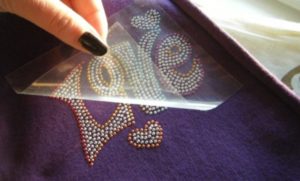 The hot-melt version differs from all other types of rhinestones by the presence of an adhesive composition on the decoration itself. High temperature turns the glue into a viscous mass, penetrating into the fabric and hardening, attaching the decor to the fabric.
The hot-melt version differs from all other types of rhinestones by the presence of an adhesive composition on the decoration itself. High temperature turns the glue into a viscous mass, penetrating into the fabric and hardening, attaching the decor to the fabric.
Not every fabric is suitable - its density should be medium so that the glue can seep between the fibers. Cotton, linen, wool are ideal. With thin and super-dense fabrics, the operation is ineffective: organza is unable to absorb glue, and polyamide does not allow it to pass through. They also have a bad relationship with high temperatures.
What will you need?
Minimum effort, time, materials and tools:
- set of rhinestones;
- iron;
- item made of suitable fabric;
- several sheets of blank paper.
Advice! It is better to glue decorations onto a finished piece of clothing - cutting and sewing already decorated fabric is inconvenient. It is recommended to pre-wash the item, and immediately before work, remove dust particles and lint with a clothes roller.
Gluing rhinestones step by step
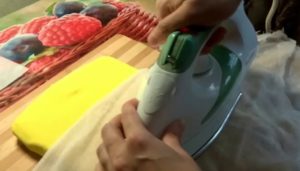 Having selected and prepared the material and rhinestones, we select a design and begin to lay it out.
Having selected and prepared the material and rhinestones, we select a design and begin to lay it out.
If you decide to risk decorating a thin-looking fabric, first place it between the fabric and layers of clothing place a sheet of paper. Neglecting this precaution, you can glue the back and front of your favorite shirt or skirt together - the adhesive composition can saturate both layers. We do the same thing if there is only one layer - there is a risk of sticking the item to the ironing board.
Now is the time to use the iron:
- set the “Cotton” mode;
- cover the rhinestone composition with a sheet of paper or cloth - the wet one will add viscosity to the glue;
- iron slowly.
There is no need to be afraid to press lightly on the iron: by pressing it against the surface for about thirty seconds, you can achieve better adhesion of the glue to the fabric. Large jewelry may require longer heating times.. There is no need to press the iron with all your might - the hot-melt glue may go beyond its boundaries, and such a frame is not provided for rhinestones.
Having completed the entire operation, we leave the item to cool for at least half an hour. The temptation to check whether it has stuck well must be resisted!
Tips for a needlewoman
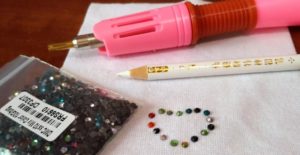 In the old days they told me to learn to embroider on matting, and then on scoured cloth. A similar recommendation is addressed to novice rhinestone decorators: Having practiced on not the best things in your wardrobe, you can understand the principle of working with decoration, find out which company supplies the best material.
In the old days they told me to learn to embroider on matting, and then on scoured cloth. A similar recommendation is addressed to novice rhinestone decorators: Having practiced on not the best things in your wardrobe, you can understand the principle of working with decoration, find out which company supplies the best material.
Be sure to take into account the presence of other accessories on clothing: Zippers and buttons may prevent the iron from smoothly finishing the rhinestone surface.
Advice! Places with small surfaces that are difficult to reach with an iron can be decorated with a soldering iron, gluing each part separately. Don't know how or are afraid to work with a soldering iron? You can use a candle and tweezers: after heating each rhinestone on the fire, quickly and carefully glue it. The method is also good for fabrics that do not like high temperatures.
Having mastered pasting clothes with thermal rhinestones, you can try decorating shoes - for example, masking scuff marks on your favorite but slightly worn boots. For this:
- A drawing is applied with a gel pen;
- Before gluing the decor, the trace of the handle is carefully wiped off with a cotton swab and alcohol or acetone. Acetone spread over the surface of the skin is fraught with indelible stains.!
- Using a soldering iron or a candle, each element of the pattern is glued.
Will the skin suffer from such manipulations? No - a fairly coarse material can survive heating of about 180 degrees. Only the varnished surface raises doubts.


 0
0